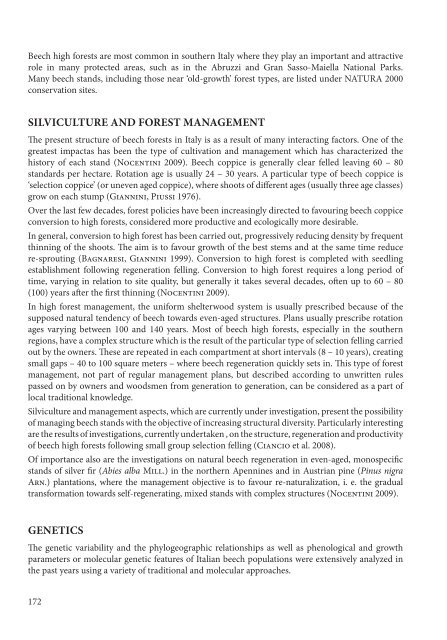Create successful ePaper yourself
Turn your PDF publications into a flip-book with our unique Google optimized e-Paper software.
Beech high forests are most common in southern Italy where they play an important and attractive<br />
role in many protected areas, such as in the Abruzzi and Gran Sasso-Maiella National Parks.<br />
Many beech stands, including those near ‘old-growth’ forest types, are listed un<strong>de</strong>r NATURA 2000<br />
conservation sites.<br />
sILvIcuLTure aNd ForesT maNaGemeNT<br />
The present structure of beech forests in Italy is as a result of many interacting factors. One of the<br />
greatest impactas has been the type of cultivation and management which has characterized the<br />
history of each stand (Nocentini 2009). Beech coppice is generally clear felled leaving 60 – 80<br />
standards per hectare. Rotation age is usually 24 – 30 years. A particular type of beech coppice is<br />
‘selection coppice’ (or uneven aged coppice), where shoots of different ages (usually three age classes)<br />
grow on each stump (Giannini, Piussi 19 6).<br />
Over the last few <strong>de</strong>ca<strong>de</strong>s, forest policies have been increasingly directed to favouring beech coppice<br />
conversion to high forests, consi<strong>de</strong>red more productive and ecologically more <strong>de</strong>sirable.<br />
In general, conversion to high forest has been carried out, progressively reducing <strong>de</strong>nsity by frequent<br />
thinning of the shoots. The aim is to favour growth of the best stems and at the same time reduce<br />
re-sprouting (Bagnaresi, Giannini 1999). Conversion to high forest is completed with seedling<br />
establishment following regeneration felling. Conversion to high forest requires a long period of<br />
time, varying in relation to site quality, but generally it takes several <strong>de</strong>ca<strong>de</strong>s, often up to 60 – 80<br />
(100) years after the first thinning (Nocentini 2009).<br />
In high forest management, the uniform shelterwood system is usually prescribed because of the<br />
supposed natural ten<strong>de</strong>ncy of beech towards even-aged structures. Plans usually prescribe rotation<br />
ages varying between 100 and 140 years. Most of beech high forests, especially in the southern<br />
regions, have a complex structure which is the result of the particular type of selection felling carried<br />
out by the owners. These are repeated in each compartment at short intervals (8 – 10 years), creating<br />
small gaps – 40 to 100 square meters – where beech regeneration quickly sets in. This type of forest<br />
management, not part of regular management plans, but <strong>de</strong>scribed according to unwritten rules<br />
passed on by owners and woodsmen from generation to generation, can be consi<strong>de</strong>red as a part of<br />
local traditional knowledge.<br />
Silviculture and management aspects, which are currently un<strong>de</strong>r investigation, present the possibility<br />
of managing beech stands with the objective of increasing structural diversity. Particularly interesting<br />
are the results of investigations, currently un<strong>de</strong>rtaken , on the structure, regeneration and productivity<br />
of beech high forests following small group selection felling (Ciancio et al. 2008).<br />
Of importance also are the investigations on natural beech regeneration in even-aged, monospecific<br />
stands of silver fir (Abies alba Mill.) in the northern Apennines and in Austrian pine (Pinus nigra<br />
Arn.) plantations, where the management objective is to favour re-naturalization, i. e. the gradual<br />
transformation towards self-regenerating, mixed stands with complex structures (Nocentini 2009).<br />
GeNeTIcs<br />
The genetic variability and the phylogeographic relationships as well as phenological and growth<br />
parameters or molecular genetic features of Italian beech populations were extensively analyzed in<br />
the past years using a variety of traditional and molecular approaches.<br />
1 2

















